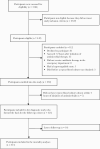Neither Blood Culture Positivity nor Time to Positivity Is Associated With Mortality Among Patients Presenting With Severe Manifestations of Sepsis: The FABLED Cohort Study
- PMID: 34307728
- PMCID: PMC8294679
- DOI: 10.1093/ofid/ofab321
Neither Blood Culture Positivity nor Time to Positivity Is Associated With Mortality Among Patients Presenting With Severe Manifestations of Sepsis: The FABLED Cohort Study
Abstract
Background: Sepsis is a leading cause of morbidity, mortality, and health care costs worldwide.
Methods: We conducted a multicenter, prospective cohort study evaluating the yield of blood cultures drawn before and after empiric antimicrobial administration among adults presenting to the emergency department with severe manifestations of sepsis. Enrolled patients who had the requisite blood cultures drawn were followed for 90 days. We explored the independent association between blood culture positivity and its time to positivity in relation to 90-day mortality.
Results: Three hundred twenty-five participants were enrolled; 90-day mortality among the 315 subjects followed up was 25.4% (80/315). Mortality was associated with age (mean age [standard deviation] in those who died was 72.5 [15.8] compared with 62.9 [17.7] years among survivors; P < .0001), greater Charlson Comorbidity Index (2 [interquartile range {IQR}, 1-3] vs 1 [IQR, 0-3]; P = .008), dementia (13/80 [16.2%] vs 18/235 [7.7%]; P = .03), cancer (27/80 [33.8%] vs 47/235 [20.0%]; P = .015), positive quick Sequential Organ Failure Assessment score (57/80 [71.2%] vs 129/235 [54.9%]; P = .009), and normal white blood cell count (25/80 [31.2%] vs 42/235 [17.9%]; P = .02). The presence of bacteremia, persistent bacteremia after antimicrobial infusion, and shorter time to blood culture positivity were not associated with mortality. Neither the source of infection nor pathogen affected mortality.
Conclusions: Although severe sepsis is an inflammatory condition triggered by infection, its 90-day survival is not influenced by blood culture positivity nor its time to positivity.
Clinical trials registration: NCT01867905.
Keywords: bacteremia; bloodstream infection; mortality; sepsis; survival.
© The Author(s) 2021. Published by Oxford University Press on behalf of Infectious Diseases Society of America.
References
-
- Cohen J, Vincent JL, Adhikari NK, et al. . Sepsis: a roadmap for future research. Lancet Infect Dis 2015; 15:581–614. - PubMed
-
- Rhodes A, Evans LE, Alhazzani W, et al. . Surviving Sepsis Campaign: international guidelines for management of sepsis and septic shock: 2016. Crit Care Med 2017; 45:486–552. - PubMed
-
- Fleischmann C, Scherag A, Adhikari NK, et al. . International Forum of Acute Care Trialists . Assessment of global incidence and mortality of hospital-treated sepsis. Current estimates and limitations. Am J Respir Crit Care Med 2016; 193:259–72. - PubMed
Associated data
LinkOut - more resources
Full Text Sources
Medical


